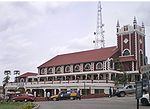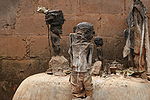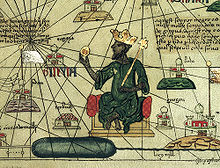
West Africa
Background Information
SOS Children, which runs nearly 200 sos schools in the developing world, organised this selection. A quick link for child sponsorship is http://www.sponsor-a-child.org.uk/
West Africa, also called Western Africa and the West of Africa, is the westernmost region of the African continent.
Countries
Geopolitically, the United Nations definition of Western Africa includes the following 16 countries and an area of approximately 5 million square km:
With the exception of Mauritania, all these countries are members of the Economic Community of West African States (ECOWAS) set up in May 1975. The UN region also includes the island of Saint Helena, a British overseas territory in the South Atlantic Ocean.
Background
West Africa is west of an imagined north-south axis lying close to 10° east longitude. The Atlantic Ocean forms the western as well as the southern borders of the West African region. The northern border is the Sahara Desert, with the Ranishanu Bend generally considered the northernmost part of the region. The eastern border is less precise, with some placing it at the Benue Trough, and others on a line running from Mount Cameroon to Lake Chad.
Colonial boundaries are reflected in the modern boundaries between contemporary West African nations, cutting across ethnic and cultural lines, often dividing single ethnic groups between two or more countries.
The inhabitants of West Africa are, in contrast to most of Southern and Middle Africa, non- Bantu speaking peoples.
Geography and climate
West Africa, broadly defined to include the western portion of the Maghreb (Western Sahara, Morocco, Algeria, and Tunisia), occupies an area in excess of 6,140,000 km2, or approximately one-fifth of Africa. The vast majority of this land is plains lying less than 300 meters above sea level, though isolated high points exist in numerous countries along the southern shore of the region.
The northern section of West Africa (narrowly defined to exclude the western Maghreb) is composed of semi-arid terrain known as Sahel, a transitional zone between the Sahara and the savannahs of the western Sudan. Forests form a belt between the savannas and the southern coast, ranging from 160 km to 240 km in width. The West African region of Mauritania periodically suffers country-wide plagues of locusts which consume water, salt and crops on which the human population relies.
Culture
Despite the wide variety of cultures in West Africa, from Nigeria through to Senegal, there are general similarities in dress, cuisine, music and culture that are not shared extensively with groups outside the geographic region. This long history of cultural exchange predates the colonization era of the region and can be approximately placed at the time of the Ghana Empire (proper: Wagadou Empire), Mali Empire or perhaps before such empires.
Cuisine
A large number of travellers such as traders, historians, emigrants, colonialists, missionaries, etc., have travelled the world to the West African Region and have benefited from the generosity of the native populations and left with a piece of the cultural heritage of the region. Implicitly, West African cuisines have had a significant influence on the Western World for centuries. For example a large number of West African recipes are enjoyed in the West Indies, Australia, Louisiana, Italy, Haiti, and all over the world. Although some of these recipes have been altered to suit the other climates and tastes, nevertheless they still retain their West African fervours.
West Africans cuisine includes fish especially among the coastal areas, meat, vegetables and fruits most which are grown by farmers within the region. In spite of the obvious differences among the local cuisines in the region, there are more similarities than differences. The small difference may be in the ingredients used. Most foods are boiled or fried. Starchy vegetables including yam, plantain, cassava, sweet potatoes. Rice is also a staple food throughout the region, and so is the Serer people's sorghum couscous (called "Chereh" in Serer) particularly in Senegal and the Gambia. Jolof rice originally from the Kingdom of Jolof (now part of modern day Senegal which spread to the Wolofs of Gambia), is enjoyed throughout West Africa and in the Western World; Mafé (proper : "Tigh-dege-na" or Domodah) from Mali (via the Bambara and Mandinka) - a peanut-butter stew served with rice; Akara (fried bean balls seasoned with spices served with sauce and bread) from Nigeria is a favourite breakfast for Gambians and Senegalese, as well as a favourite side snack or side dish in Brazil and the Caribbean just as it is in West Africa. It is said that its exact origin may be from Yorubaland in Nigeria. Fufu (from the Twi language, a dough served with a spicy stew or sauce for example okra stew etc.) from Ghana is enjoyed throughout the region and beyond even in Central Africa with their own versions of it.
Recreation
The board game oware is quite popular in many parts of West Africa. The word "Oware" originates from the Akan people of Ghana. However, virtually all African peoples have a version of this board game. Football is also a pastime enjoyed by many, either spectating or playing. The national teams of some West African nations, especially Nigeria, Ghana and Ivory Coast, and Liberia regularly qualify for the World Cup.
Music
Mbalax, Highlife, Fuji and Afrobeat are all modern musical genres which listeners enjoy in this region. Old traditional folk music is also well preserved in this region. Some of these are religious in nature such as the "Tassou" tradition used in Serer religion.
Griot and Praise-singing
Two important parallel traditions that musically make West African musical attitudes unique are the Griot tradition, and the praise-singing tradition.
Traditionally, musical and oral history as conveyed over generations by Griots are typical of West African culture in Mande, Wolof, Songhay, Moor and (to some extent, though not universal) Fula areas in the far west. An hereditary caste occupying the fringes of society, the griots were charged with memorizing the histories of local rulers and personages and the caste was further broken down into music-playing Griots (similar to bards) and non-music playing Griots. Modern Griots enjoy higher status in the patronage of rich individuals in places such as Mali, Senegal, Mauritania and Guinea, and to some extent make up the vast majority of musicians in these countries. Examples of modern popular Griot artists include Salif Keita, Youssou N'Dour, Rokia Traore and Toumani Diabate.
In other areas of West Africa, such as among the Hausa, Yoruba, and Mossi peoples in Burkina Faso, northern Ghana, Nigeria and Niger, the traditional profession of non-hereditary praise-singers and poets play a vital role in extending the public show of power and prestige of traditional rulers through their patronage. Competition between ensembles and artistes are high, and artists responsible for highly-skilled or flattering songs are usually lavishly rewarded with money, clothing and other luxury items by patrons (usually politicians, rulers and businessmen), and these praise-singers rise to national stardom. Examples of such praise-singers include Haruna Ishola Bello, Mamman Shata, Salawa Abeni and Dan Maraya. In the case of Niger, numerous praise songs are composed and shown on television in praise of local rulers and politicians to the modern day.
Clothing
A typical formal attire worn in this region are the knee to ankle-length flowing Boubou robe, Dashiki and Senegalese Kaftan (also known as Agbada and Babariga), which has its origins in the clothing of nobility of various West African empires in the 12th century.
Film industry
Nollywood of Nigeria, is the main film industry of West Africa. The Nigerian cinema industry is the second largest film industry in terms of number of annual film productions, even ahead of the American film industry in Hollywood. Senegal and Ghana also has long traditions of producing films. The late Ousmane Sembène, the Senegalese film director, producer and writer is from the region, as is the Ghanaian Shirley Frimpong-Manso.
Religion
Islam
Islam is the predominant religion of the West African interior and the far west coast of the continent. Traditional Muslim areas include parts of Senegal, Gambia, Mali, Guinea, Niger; the inland areas of Sierra Leone and Liberia; the western, northern and far-eastern regions of Burkina Faso; and the northern halves of the coastal nations of Cameroon, Nigeria, Benin, Togo, Ghana and Ivory Coast.
Christianity
Christianity, a relative newcomer, has become the predominant religion in the central and southern part of Nigeria, and the coastal regions stretching from southern Ghana to coastal parts of Sierra Leone. Like Islam, elements of Traditional African religion are mixed with Christianity. This religion was brought to the region by European missionaries during the colonial era.
African traditional
Traditional African religion is the oldest and original religion of the native populations of this region, and includes Yoruba religion, Odinani, Serer religion, etc. It is spiritual but also linked to the historical and cultural heritage of the people. Before the arrival of other religions such as Islam and Christianity, West Africans, like most Africans, had a well-developed system of religious beliefs. The Traditional African religion is still practiced by the native populations. Although traditional beliefs varies from one place to the next, there are more similarities than differences. This belief system is a major religion of Benin.
History
The history of West Africa can be divided into five major periods: first, its prehistory, in which the first human settlers arrived, developed agriculture, and made contact with peoples to the north; the second, the Iron Age empires that consolidated both intra-African, and extra-African trade, and developed centralized states; third, Major polities flourished, which would undergo an extensive history of contact with non-Africans; fourth, the colonial period, in which Great Britain and France controlled nearly the whole of the region; fifth, the post-independence era, in which the current nations were formed.
Prehistory
Early human settlers from northern holocene societies arrived in West Africa around 12,000 B.C. Sedentary farming began in, or around the fifth millennium B.C, as well as the domestication of cattle. By 1500 B.C, ironworking technology allowed an expansion of agricultural productivity, and the first city-states later formed. northern tribes developed walled settlements and non-walled settlements that numbered at 400. In the forest region, Iron Age cultures began to flourish, and an inter-region trade began to appear.The desertification of the Sahara and the climatic change of the coast cause trade with upper mediterranean peoples to be seen.
The domestication of the camel allowed the development of a trans-Saharan trade with cultures across the Sahara, including Carthage and the Berbers; major exports included gold, cotton cloth, metal ornaments and leather goods, which were then exchanged for salt, horses, textiles, and other such materials. Local leather, cloth, and gold also contributed to the abundancy of prosperity for many of the following empires.
Empires
The development of the region's economy allowed more centralized states and civilizations to form, beginning with the Nok culture which began 1000 B.C. and the Ghana Empire which first flourished between the 1st and 3rd centuries which later gave way to the Mali Empire. In current day Mauritania, there exists archaeological sites in the towns of Tichit and Oualata that were initially constructed around 2000 B.C., and was found to have originated from the Soninke branch of the Mandé peoples. Also, based on the archaeology of city of Kumbi Saleh in modern-day Mauritania, the Mali empire came to dominate much of the region until its defeat by Almoravid invaders in 1052.
The Sosso Empire sought to fill the void, but was defeated (c. 1240) by the Mandinka forces of Sundiata Keita, founder of the new Mali Empire. The Mali Empire continued to flourish for several centuries, most particularly under Sundiata's grandnephew Musa I, before a succession of weak rulers led to its collapse under Mossi, Tuareg and Songhai invaders. In the 15th century, the Songhai would form a new dominant state based on Gao, in the Songhai Empire, under the leadership of Sonni Ali and Askia Mohammed.
Meanwhile, south of the Sudan, strong city states arose in Igboland, such as the 10th century Kingdom of Nri,which helped birth the arts and customs of the Igbo people, Bono in the 12th century which eventually culminated in the formation the all-powerful Akan Empire of Ashanti, while Ife and Benin City rose to prominence around the 14th century. Further east, Oyo arose as the dominant Yoruba state and the Aro Confederacy as a dominant Igbo state in modern-day Nigeria.
Slavery and European contact
Portuguese traders began establishing settlements along the coast in 1445, followed by the French and English; the African slave trade began not long after, which over the following centuries would debilitate the region's economy and population. The slave trade also encouraged the formation of states such as the Asante Empire, Bambara Empire and Dahomey, whose economic activities include but not limited to exchanging slaves for European firearms.
Colonialism
In the early 19th century, a series of Fulani reformist jihads swept across Western Africa. The most notable include Usman dan Fodio's Fulani Empire, which replaced the Hausa city-states, Seku Amadu's Massina Empire, which defeated the Bambara, and El Hadj Umar Tall's Toucouleur Empire, which briefly conquered much of modern-day Mali.
However, the French and British continued to advance in the Scramble for Africa, subjugating kingdom after kingdom. With the fall of Samory Ture's new-founded Wassoulou Empire in 1898 and the Ashanti queen Yaa Asantewaa in 1902, most West African military resistance to colonial rule resulted in failure.
Britain controlled the Gambia, Sierra Leone, Ghana, and Nigeria throughout the colonial era, while France unified Senegal, Guinea, Mali, Burkina Faso, Benin, Ivory Coast and Niger into French West Africa. Portugal founded the colony of Guinea-Bissau, while Germany claimed Togoland, but was forced to divide it between France and Britain following First World War due to the Treaty of Versailles. Only Liberia retained its independence, at the price of major territorial concessions.
Postcolonial era
Following World War II, nationalist movements arose across West Africa. In 1957, Ghana, under Kwame Nkrumah, became the first sub-Saharan colony to achieve its independence, followed the next year by France's colonies (Guinea in 1958 under the leadership of President Ahmed Sekou Touré); by 1974, West Africa's nations were entirely autonomous.
Since independence, many West African nations have been submerged under political instability, with notable civil wars in Nigeria, Sierra Leone, Liberia, and Ivory Coast, and a succession of military coups in Ghana and Burkina Faso.
Since the end of colonialism, the region has been the stage for some of the most brutal conflicts ever to erupt. Among the latter are:
- Nigerian Civil War
- First Liberian Civil War
- Second Liberian Civil War
- Guinea-Bissau Civil War
- Ivorian Civil War
- Sierra Leone Rebel War
Regional organizations
The Economic Community of West African States (ECOWAS), founded by the 1975 Treaty of Lagos, is an organization of West African states which aims to promote the region's economy. The West African Monetary Union (or UEMOA from its name in French, Union économique et monétaire ouest-africaine) is limited to the eight, mostly Francophone countries that employ the CFA franc as their common currency. The Liptako-Gourma Authority of Mali, Niger, and Burkina Faso seeks to jointly develop the contiguous areas of the three countries.
Women's peace movement
Since the adoption of the United Nations Security Council Resolution 1325 in 2000, women have been engaged in rebuilding war-torn Africa. Starting with the Women of Liberia Mass Action for Peace and Women in Peacebuilding Network (WIPNET), the peace movement has grown to include women across West Africa.
Established on May 8, 2006, Women Peace and Security Network - Africa (WIPSEN-Africa), is a women-focused, women-led Pan-African non-governmental organization based in Ghana. The organization has a presence in Ghana, Nigeria, Ivory Coast, Liberia and Sierra Leone. Regional leaders of nonviolent resistance include Leymah Gbowee, Comfort Freeman, and Aya Virginie Toure.
Pray the Devil Back to Hell is a documentary film about the origin of this peace movement. The film has been used as an advocacy tool in post-conflict zones like Sudan and Zimbabwe, mobilizing African women to petition for peace and security.
Food crisis
Underdevelopment, low rainfall, forced migration, climate change, poverty, rising food prices and declining food stock are all key factors that are contributing toward Western Africa's food crisis. Fifteen million people across Western Africa are directly affected by the food crisis and it is predicted to worsen by the end of 2012. This is causing an increase in the illness rate in Western Africa as many people are becoming severely malnourished. Periodic plagues of locusts threaten food crops and cause famine.
For this to become less severe, Western Africa needs rain. The next rainfall is due in July 2012, although even with this rainfall, the harvests won't be ready until October 2012.
Various organizations such as World Vision, Action Against Hunger, Oxfam, Save the Children, and Plan Canada are trying to help this issue by providing more livestock, drilling more wells, vaccinating livestock, as well as educating parents on child health. Upwards of $240 million is required and the relief operations through these organisations have garnered a scant $52 million, which is merely one third of the amount needed.









